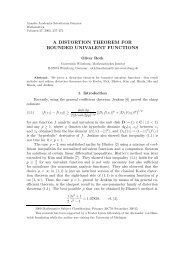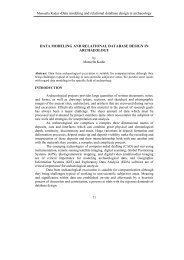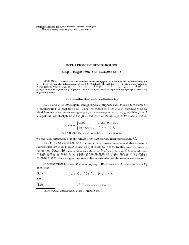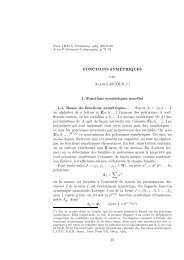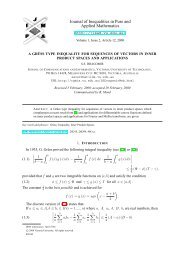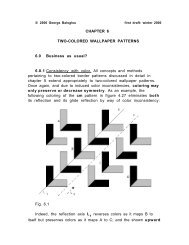SUPERNOMIAL COEFFICIENTS, BAILEY'S LEMMA AND ROGERS ...
SUPERNOMIAL COEFFICIENTS, BAILEY'S LEMMA AND ROGERS ...
SUPERNOMIAL COEFFICIENTS, BAILEY'S LEMMA AND ROGERS ...
You also want an ePaper? Increase the reach of your titles
YUMPU automatically turns print PDFs into web optimized ePapers that Google loves.
18 S. O. WARNAARThen, for L, M ∈ Z + ,∑ ∑(7.6) ɛ(σ)q φ p,k,σT ′′ (L, M, pk − σ + ρ, (p − 1)k − σ + ρ)σ∈S n|k|=0= ∑ µwith sum over η as in (7.1) and η given by[ ][ ]q 1 2 µ(C−1 ⊗C)µ M + nL −∑b C−1 1,b µ(b) 1 µ + ηnLµη = nL(C −1 e 1 ⊗ e 1 ) − (C −1 ⊗ C)µ.The left-hand side of this identity coincides with the generating function intheorem 3 of [17] with r → n, λ → (L n ), µ → (0 n ), d → p − n, α → (0 p−n ),β → (0, . . . , 0, n − p + 1), a i → M and b i → 0. For p = n + 1 the above isidentity (6.2) of [17].We note that (7.4), (7.5) and (7.6) are consistent. Specifically, (7.4) withM 2 → ∞ and (7.6) with L → ∞ coincide (identifying M 1 with M), and (7.5)with L = ((n−1)L 1 , . . . , 2L 1 , L 1 ) and (7.6) with M → ∞ coincide (identifyingL 1 and L).The three above conjectures strongly suggest the existence of a unifyingidentity of the form∑ ∑(7.7) ɛ(σ)q φ p,k,σT (L, M, pk − σ + ρ, (p − 1)k − σ + ρ)σ∈S n|k|=0= ∑ µn−1q 1 2 µ(C−1 ⊗C)µ∏( [ M a + (CL) a − ∑ b C−1a=1(CL) aa,b µ(b) 1] ) [ ] µ + ηwith sum over µ such that (7.1) holds, η given by (7.2) and L, M ∈ Z n−1+ . Thegeneralized supernomial T (L, M, k, k ′ ) (where L, M ∈ Z n−1 , k, k ′ ∈ Z n and|k| = |k ′ | = 0) must satisfy the following consistency conditions:lim T (L, (M 1 , 0 n−3 , M 2 ), k, k ′ ) = T ((M 1 , M 2 ), k)(q) M1 +MCL→(∞ n−1 2)lim T (L, M, k, k ′ ) = T ′ (L, k)M→(∞ n−1 )T (((n − 1)L 1 , . . . , 2L 1 , L 1 ), (M 1 , 0 n−2 ), k, k ′ ) = T ′′ (L 1 , M 1 , k, k ′ ).(The first condition applies when n ≥ 3 only.) A further restriction on thepossible form of T is obtained by observing that the right-hand side is, up toa factor q MCL , invariant under the change q → 1/q, so thatT (L, M, k, k ′ ; 1/q)T (L, M, k, k ′ ; q)= q −MCL+∑ ni=1 k ik ′ i .Despite these strong restrictions on T (especially when n = 3) we have notsucceeded in finding a closed form expression when n ≥ 3. For n = 2 theµ


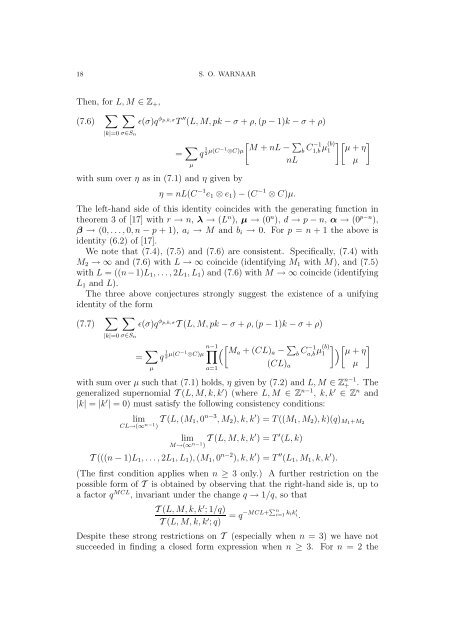
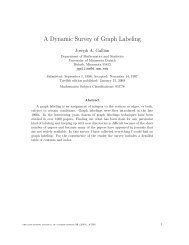


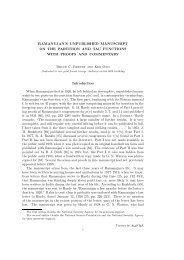
![(.,t ] and [s, .) , where [s,t ] = {s' GT; s ¤ s' ¤ t} , (.,t ] = {s' GT; s' ¤ t} and ...](https://img.yumpu.com/43303393/1/184x260/t-and-s-where-st-s-gt-s-a-s-a-t-t-s-gt-s-a-t-and-.jpg?quality=85)


